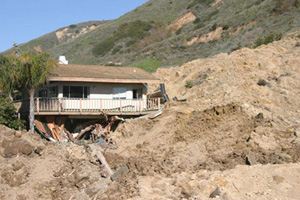Landslide Hazards

Have you seen headlines like these in the news at some point?
“California landslides prompt evacuations of homes”
“Landslides kill 50 people after massive earthquake”
You will often hear the term landslide applied to several types of mass movement. The term landslide  applies to a variety of things including mudflows, rock slides, debris flows, earth flows, slumps, and avalanches. Landslides of all varieties are common after earthquakes and volcanic eruptions, and they are often a secondary threat to human life after the primary natural disaster. After an earthquake, soil liquefaction (solid turns liquid) weakens the ground, often triggering a landslide. The loss of vegetation after a wildfire can also trigger a landslide.
applies to a variety of things including mudflows, rock slides, debris flows, earth flows, slumps, and avalanches. Landslides of all varieties are common after earthquakes and volcanic eruptions, and they are often a secondary threat to human life after the primary natural disaster. After an earthquake, soil liquefaction (solid turns liquid) weakens the ground, often triggering a landslide. The loss of vegetation after a wildfire can also trigger a landslide.
In the United States alone, landslides do billions of dollars of damage every year. They take human life and destroy roads, homes, and businesses. They happen in all 50 states, but they are especially common in mountainous areas. Human population growth has made landslide hazards more prevalent, as sloped land is developed to build more homes and people seek home sites with impressive mountain views. Often these homes are not covered by landslide insurance; insurance companies rarely pay for damages caused by landslides. Landslides also harm wildlife by damaging habitat and polluting water with soil and rock debris.